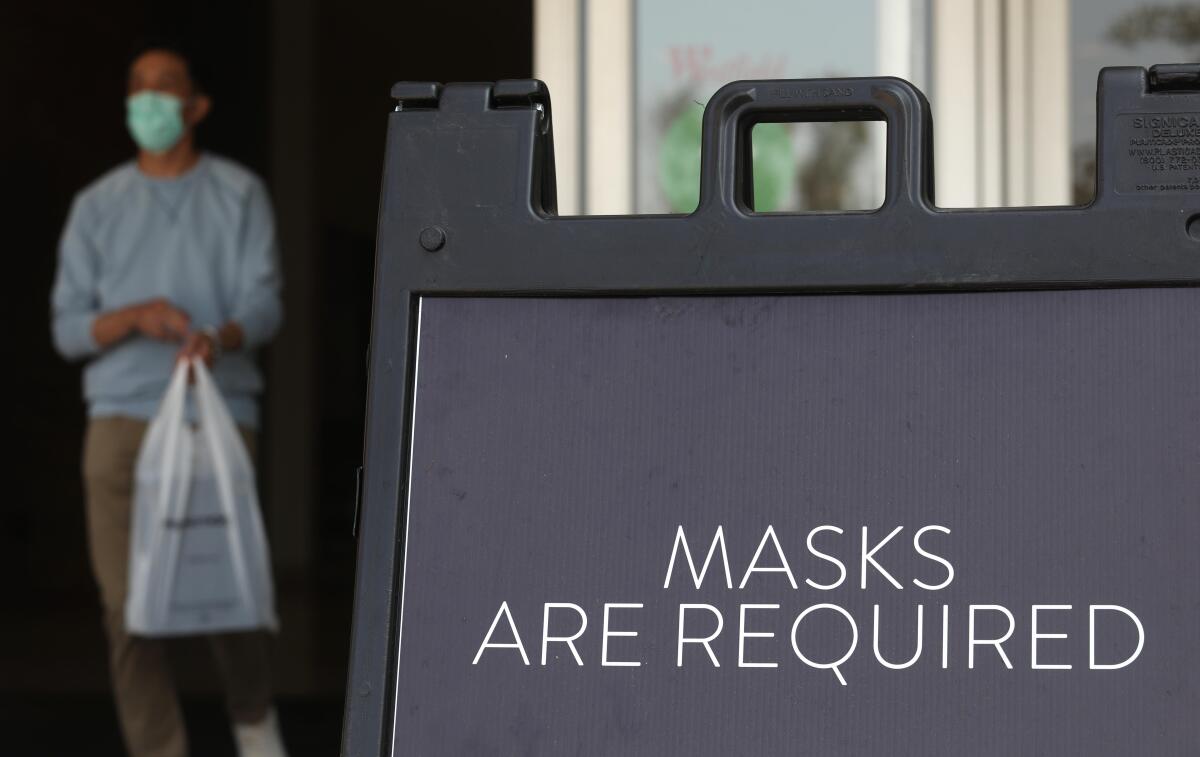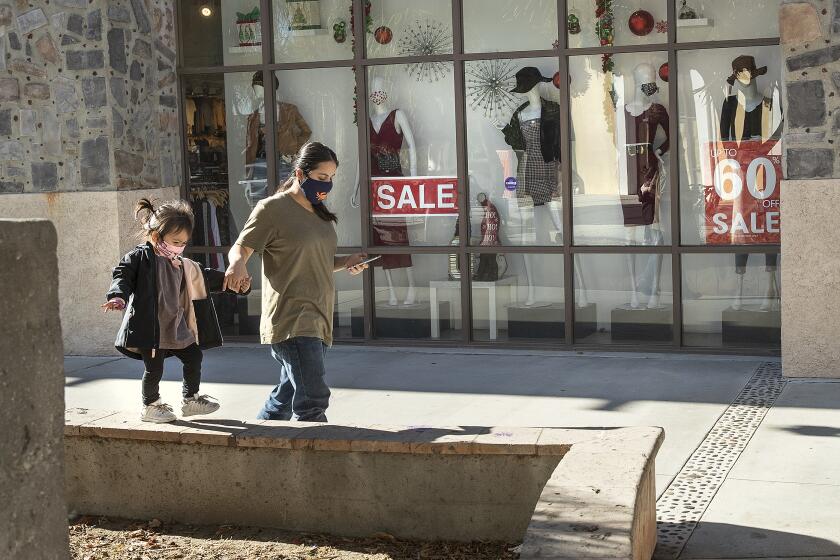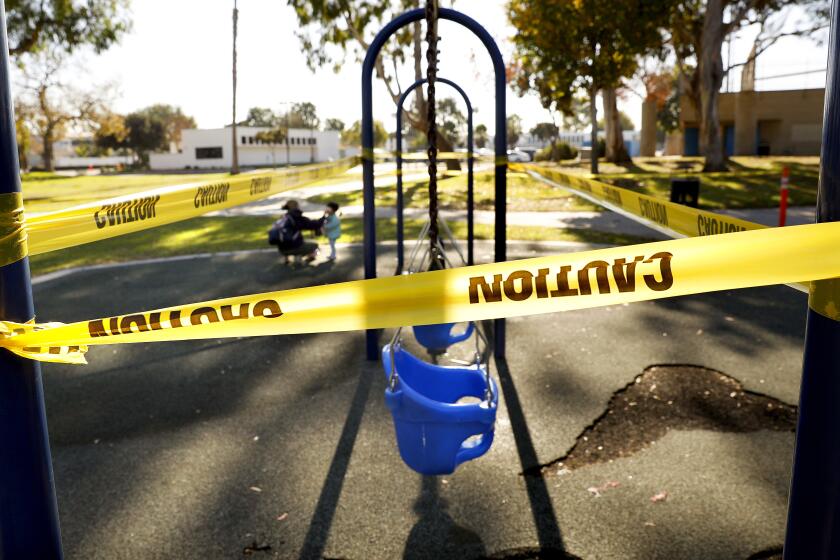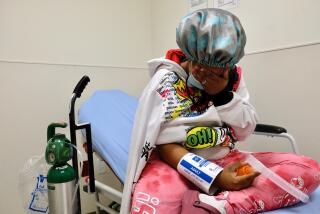Stay-at-home order will be imposed in Southern California and San Joaquin Valley

- Share via
A stay-at-home order will go into effect in Southern California and the San Joaquin Valley late Sunday, as COVID-19 cases soar and capacity at hospital intensive care units continues to drop.
The regions will implement the order Sunday at 11:59 p.m. Bars, wineries and personal-care services must close; restaurants must halt all dining; and gatherings of people from different households will be prohibited, the state confirmed. The rules will remain in place for at least three weeks.
The order — the latest in a series of attempts to slow the spread of the coronavirus and prevent local healthcare systems from becoming overwhelmed — is triggered when a region’s ICU capacity drops below 15%. Southern California’s ICU capacity Saturday was 12.5%, and the San Joaquin Valley’s was 8.6%, according to data released by the state.
Some 33 million Californians will be subject to the new order, representing 84% of the state’s population. They include residents of five Bay Area counties, which have decided to implement the stay-at-home order despite not yet reaching the threshold mandated by the state.
The order will be felt across Southern California but most dramatically in suburban counties like Orange, Ventura and Riverside, which have far less stringent restrictions than Los Angeles County, which imposed a modified stay-at-home order a week ago.
In addition to Los Angeles, Orange, Ventura and Riverside, the Southern California counties affected by the order are Imperial, Inyo, Mono, San Bernardino, San Diego, San Luis Obispo, Santa Barbara and Ventura. The San Joaquin Valley region covers Calaveras, Fresno, Kern, Kings, Madera, Mariposa, Merced, San Benito, San Joaquin, Stanislaus, Tulare and Tuolumne counties.
Stay-at-home is unpopular and it crushes businesses. But it might be California’s only option
Affected communities will be required to close hair and nail salons, playgrounds, zoos, museums, aquariums and wineries. Overnight, short-term stays at campgrounds will be prohibited. Restaurants will be allowed to offer takeout service only.
Retail businesses will be limited to 20% customer capacity indoors, and stores will be required to ensure that there is no indoor eating or drinking.
Card rooms will be required to shut down, and hotels won’t be allowed to accept tourists.
Entertainment productions and professional sports will continue to be allowed, without live audiences. The exception is Santa Clara County, which on Monday enacted a ban on contact sports, forcing the San Francisco 49ers to temporarily relocate to Arizona for December games.
By Tuesday, the stay-at-home orders will be in effect in 28 counties encompassing 84% of California’s population
Officials have said the measures are needed to avoid a crush of COVID-19 patients that could overwhelm the healthcare system, jeopardizing the ability to care for non-COVID patients as well. Mortality rates can dramatically increase when ICUs are stretched beyond capacity, and officials have warned that there are limits on the number of doctors, nurses and other healthcare providers who are well-trained in providing intensive care. Quality of care can fall substantially if hospitals are forced to transfer critically ill patients to parts of the hospital that are not designed for such use.
California has broken the record for COVID-19 hospitalizations for seven consecutive days, with 9,430 on Friday — more than quadruple the number from Oct. 24, when there were 2,254.
The state’s hospitals have never had so many severely ill COVID-19 patients; there are currently 2,182 in the ICU, the third consecutive day the record has been broken. During the COVID-19 surge in the summer, there were never more than 2,058 patients in the ICU.
In L.A. County, hospitalizations increased to 2,855 on Friday from 2,769 on Thursday. That number will likely continue to rise, as 49,000 people tested positive over the past week, and about 10% of them are expected to require hospital care, Barbara Ferrer, the county health director, said Saturday.
“That translates to close to 5,000 patients, and if even 20% of these patients need care in the ICU, they will require 1,000 staffed ICU beds,” Ferrer said in a statement. “This is our likely reality in two weeks.
“And if we all can’t get behind the existing directives to stay home as much as possible and avoid all nonessential activities and places where you are likely to be in contact with non-household members, we are likely to bear witness to one of the worst healthcare crises our county has seen in our lifetime,” she said.
In the San Joaquin Valley region, some hospitals are already strained.
“We are at a point where surging cases and hospitalizations are not letting up,” Dr. Salvador Sandoval, Merced County’s public health officer, said in a statement.
The only hospital in San Benito County is “completely full,” Dr. David Ghilarducci, the county’s public health officer, said in a statement. “This is an alarming situation that could get much worse.”
Remote counties are dependent on neighboring areas for care, officials said, meaning that if one or two hospitals become overwhelmed, a domino effect could occur.
“Our mountain communities rely on the region for ICU-level care for COVID and other serious medical conditions, transferring our sickest to hospitals in the San Joaquin Valley,” said Dr. Eric Sergienko, health officer for Mariposa County and acting health officer for Tuolumne County. “These hospitals are stretched to capacity.”
Word of the new stay-at-home order came as California and Los Angeles County continued to set records for coronavirus cases reported in a single day.
A county-by-county tally by The Times found that more than 22,300 new coronavirus cases were reported across California on Friday, exceeding the record set Monday, when there were 21,848. Over the last week, the state has averaged more than 17,800 new cases per day. The Times tallied 204 COVID-19 deaths Friday, the second-highest total recorded in a single day.
Cumulatively, California has reported more than 1.3 million coronavirus cases and more than 19,800 deaths.
L.A. County has broken single-day coronavirus case records in four of the last five days. On Saturday, at least 9,109 cases were reported, according to preliminary numbers in The Times’ independent tally, breaking the records set Friday, when 8,562 cases were reported, and Thursday, when 7,713 were reported.
The latest maps and charts on the spread of COVID-19 in Los Angeles County, including cases, deaths, closures and restrictions.
With at least 43 deaths recorded Saturday, L.A. County is averaging 38 deaths a day, a pace not seen since late July.
The new stay-at-home order has faced criticism from all sides. Some say it’s too restrictive and will destroy small businesses; others question whether the rules are tough enough, wondering why malls are allowed to stay open.
Some local officials have also criticized the way the state has designated regions for the purpose of measuring ICU capacity. Officials of Ventura County noted that the Southern California region into which it falls is home to more than half the state’s population and are urging Gov. Gavin Newsom “to consider smaller, more targeted regions.”
San Luis Obispo County issued a similar statement, saying its ICU capacity is higher than that of most other counties in the Southern California region.
“We are disappointed to be categorized in the Southern California region and continue to ask state officials to reconsider our regional assignment to better represent the local ICU capacity,” said Dr. Penny Borenstein, San Luis Obispo County’s health officer.
Orange County Supervisor Lisa Bartlett said she supports a regionalized approach so that counties can assist each other if their hospitals fill up, but the state’s categories are simply too broad.
“Grouping 11 counties in Southern California into one region, particularly with one county that represents over 25% of the state’s population, is problematic,” she said, referring to L.A. County, the state’s most populous.
Bartlett noted that Orange County’s ICU capacity is more than 20%, compared with the regional availability of 12.5%. By being forced to shut down or reduce operations, she said, some business sectors, like restaurants and theme parks, are being “unfairly punished” by the new rules.
Keegan Hicks, owner of the Harbor Grill in Dana Point, said the popular restaurant was completely booked Saturday night. He said the restaurant will comply with the new order but believes there should be an exception for outdoor dining.
“We understand why these measures are being taken. We have nothing but concern and solidarity for frontline hospital workers,” said Hicks, whose family has owned the restaurant for 36 years. “But we believe that outdoor dining — as long as the restaurant is taking the proper protocols — is not responsible for the spread of the coronavirus.
“We’ve been open since May,” he added. “We have 60 employees and have had zero transmission among employees and zero customer complaints.”
Hilary Goldner, co-owner of Sweet 1017 Hairdressing in Seal Beach, heard the news about the order through text messages from her staff. After a busy Saturday, she is getting ready to close her salon for three weeks.
“It’s devastating,” she said. “We had had the two closures already, and this one comes at the busiest time of the year. Everyone is trying to move forward with their lives, and we play a role in that. It’s unfortunate and disappointing.”
Goldner said she understands that hospitals are getting slammed, but she doesn’t believe hair salons are contributing to the spread of COVID-19.
“We feel that we are already in compliance,” she said. “We’re in masks; our clients are in masks. We’re sanitizing. We’re going above and beyond for the safety of our clients.”
Orange County Sheriff Don Barnes said Saturday that deputies will not be dispatched to enforce compliance with stay-at-home rules or those governing face coverings and social distancing — as has been the department’s policy throughout the pandemic.
“Compliance with health orders is a matter of personal responsibility and not a matter of law enforcement,” he said in a statement.
Bartlett said she and Orange County Supervisor Don Wagner plan to introduce a resolution on Tuesday affirming the county’s commitment to advocating for local control to the greatest extent possible. She said county officials have been working with public health officers and hospitals to increase ICU capacity by such measures as reopening the Fairview Developmental Center as a field hospital to treat COVID-19 patients, which could potentially add 180 beds.
Still, she said, there’s “great concern” about what will happen in a few weeks, when cases may spike further due to the possibility of increased transmission from Thanksgiving gatherings.
“Based on our current ICU bed capacity, I think Orange County is in fairly good shape, but that could also change very quickly,” Bartlett said. “Our ICU bed capacity literally dropped 15% in one week. So we have to watch things very carefully.”
What’s the reasoning behind Los Angeles County’s new restrictions designed to stop the coronavirus from spreading? We assess the science behind each one.
More to Read
Sign up for Essential California
The most important California stories and recommendations in your inbox every morning.
You may occasionally receive promotional content from the Los Angeles Times.

















